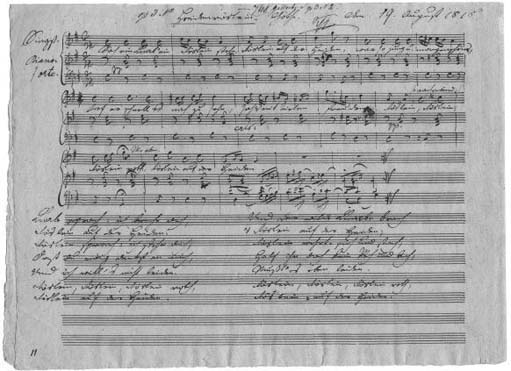4.1.1 ‘Heidenröslein’ (‘Wild Rose’, 1815) and ‘Wandrers Nachtlied’ (‘Wanderer's Night Song II’, 1822)
The selection in this course begins with songs composed to two of Goethe's best-known poems (several composers other than Schubert wrote settings of them). Schubert's versions are both very short and simple. But they are simple in quite different ways.
Exercise 3
Click the links below to listen to these two songs and look at the musical score of Heidenröslein . First read through the poem in English (click the link below), and then follow the words in the parallel text as you listen to each song. You should find that, even if you have little or no knowledge of German, you will, with a little practice, be able to follow the German words as they are sung, and to keep an eye on the meaning through reference to the English translation. Without attempting any detailed analysis, consider in general terms the main differences in character between the two poems and the two songs.
Click below to listen to Heidenröslein.
Click below to listen to Wanderers Nachtlied II.
Click to read these two songs in English and German [Tip: hold Ctrl and click a link to open it in a new tab. (Hide tip)]
Click to view the musical score for Heidenröslein
Discussion
In the following and subsequent discussions I will offer you my analysis of the question I have posed. If you have not had much experience of trying to analyse music, I realise that you are unlikely to think of everything I suggest. But don't be disheartened by this. If you find it more helpful, you could read through my discussion before attempting the exercise, and then set yourself the task of recognising and understanding my comments. Or you could work through the exercise on your own before seeing what I have made of it.
There are a number of features of the poem ‘Heidenröslein’ which make it very like a folk-song: the simple rhyme-scheme (AB-AAB-CB) which is repeated in each verse, the repeated refrain of the last two lines, and the mock-innocent story of the boy plucking the rose, which is obviously not just about roses.
Schubert's setting is also simple, and does not distract from the folk-song style of Goethe's poem. He adheres to the pattern of three verses, repeating the same music for each verse (the musical term for this method of setting is ‘strophic’). In the manuscript (see Figure 4) he just writes the music out once, with the words of the first verse placed underneath the voice-part, and verses 2 and 3 given at the bottom of the page (as in a modern hymn-book). In the published edition, the words of the three verses are all fitted under the voice-part, making it easier to follow words and music together. The piano part consists of a regular pattern of chords, continuing until the singer has finished each verse, and then rounding off the verse with a slightly varied repetition of the singer's last phrase. There are subtleties in Schubert's choice of chords, the most noticeable effect of which is that lines 3–5 of each verse seem to ‘run through ‘without any sense of coming to rest until the end of line 5 (‘Freuden’ in verse 1). This helps to emphasise Goethe's verse structure, in which lines 2 and 5 rhyme.

‘Wandrers Nachtlied’ is simple, but not in the way that ‘Heidenröslein’ is. The poem has none of the feel of a folk-poem. It does rhyme, but the rhyming pattern is not as regular as in a folk-poem: it goes AB-AB-CD-DC (the rhymes in the German are full rhymes; the translation has resorted to half-rhymes for some lines – ‘still/feel, breeze/peace’). There is no division into verses. The relationship between rhyming and rhythm is subtle: the first four lines rhyme AB-AB, but Goethe undermines any sense of regularity by varying the lengths of the lines and by running the sense over from line 4 to line 5.
I think you'll agree that Schubert's setting of ‘Wandrers Nachtlied’ does not sound in the least like a folk-song. It is very slow, with long vocal lines that need the resources of a trained singer to sustain them. The piano part is quiet and deep throughout, with low bass notes emphasising the profound calm and darkness of the poem. It sounds almost like a hymn, but one of great solemnity.
One fundamental difference between these two songs is that ‘Heidenröslein’ is a narrative about a boy, though incorporating some dialogue. ‘Wandrers Nachtlied’ is not a narrative: it is sung by the wanderer himself. When he sings that peace will come soon, he is comforting himself. So the contrast is between, in the first song, a simple story, simply set like a folk-song and, in the second, a song which encapsulates a single moment of reflection, evoking a particular emotional state for its own sake, not as part of a story. We can imagine that there might have been a story, but we have to make it up for ourselves. ‘Wandrers Nachtlied’ is in that sense more Romantic in spirit than ‘Heidenröslein’. It is an example of art directly expressing emotional experience.
The idea of a wanderer expressing his or her own thoughts became a very popular theme in early nineteenth-century poetry and Lieder. A number of composers wrote ‘song-cycles’ using this idea – sequences of songs to be performed continuously, meditating on a journey. These were, in the more subtle examples of the genre, to be understood as analogous to the journey through life, and a meditation on the human condition. The most famous is Schubert's Winterreise (Winter's Journey), written in the last year of his life – a cycle of songs with a predominantly melancholy, and increasingly bleak, character, which can have an overwhelming impact in a good performance.
